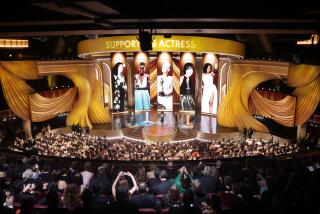David Rockwell opens curtain on 2010 Oscar set design
- Share via
Celebrities pull focus. And rightfully so: That is their job, after all.
Annual Academy Awards evenings are no exception. Billy Crystal flies across the stage (and into Charlie Chaplin films), appropriating “Ol’ Man River” and “People (Who Need People)” for his best-picture-themed musical revues. George Clooney, Sandra Bullock and other mega-stars read nonchalantly from teleprompters, adding improvised winks or quips. Hordes of hopeful dancers don garish costumes to tango or crunk through elaborate best-original-song performances. Susan Sarandon and Sean Penn make political statements.
For home viewers, Oscar watching is all about the stars. We nestle on couches, inhale junk food and make snarky or covetous comments about red-carpet gowns and tearful speeches, rarely noticing the carefully considered stage below Brad Pitt’s feet or the innovative backdrop complementing Jennifer Aniston’s figure.
And this may be the clearest indicator of a set design job well done. Mostly, viewers think about sets only if they malfunction, overshadow or act as clumsy props in over-the-top montages. The stage design subliminally sets the entire show’s tone, but its ability to be at once hospitable and unobtrusive is probably its most important function.
For the 82nd Academy Awards, David Rockwell (architect and designer of the Kodak Theatre) has returned for a second consecutive year to design the show’s sets. He is no stranger to these challenges: Rockwell has spent much of the last decade designing environments for Broadway shows including “Hairspray” and the upcoming “Catch Me If You Can.” So he attacked this year’s process with a well-honed understanding of the possibilities and pitfalls. “You have to create multiple entries, great backdrops that work from a camera’s point of view, and you have to tell the story,” he explains. “This year, there’s an awful lot of big movies, so we want to present them as at once spectacular and intimate. Director Hamish Hamilton has to be able to capture what’s onstage and the reaction shots, people winning and people on their side celebrating, which we can facilitate design-wise.”
Like the Oscars’ controversial 10 best-picture nominations, most of the set is new. But last year, Rockwell made a major edit (or a “radical intervention,” in his words) to his original theater design that worked, replacing traditional seating with tiers closer to the stage and moving the orchestra onto the stage. “It’s a one-night-only event with a real sense of occasion,” he notes. “So, you want the environment to be intimate and highlight relationships building in the room. The more those connections are translated to the home audience, the better.” Also, in an effort to curb traffic in aisles and to expedite the nominees’ stage ascendance, Rockwell created additional front-row seats.
Although slightly modified, last year’s enormous Swarovski crystal curtain will reappear too. The glittery creation is made of more than 100,000 crystals and weighs 60,000 pounds. “The curtain solves a challenge, which is that the proscenium opening is smaller than the arch of the room,” Rockwell says. “We’re remaking it, so it will ombré from the clear crystal to a new topaz fringe, creating a sharper silhouette.” Crystal side curtains have been added too.
In general, the sets will sparkle like so many Neil Lane jewels: Colors include platinum, topaz, smoky brown and clean white. The stage will be a laser-cut white on white (instead of last year’s black), evoking abstract L.A. modernism and also classic variety shows (a concept conceived with producers Bill Mechanic and Adam Shankman). “The white environment will show silhouette very beautifully, so it will be a great room for fashion too,” Rockwell says. A white fabric cyclorama will complete the stark background as an extension of the floor on three sides and also will satisfy the director’s hope of using the stage’s depth.
Most experimental for Rockwell is the use of multiple reflective surfaces in small slivers throughout the stage and auditorium from a Venetian blind-style set piece to low walls treated with frosted and polished faceted mirrors. “I’m excited to see how that allows people watching the show to see winners and presenters on the stage and the audience reaction at the same time.”
Last year, a series of five screens split and moved to reveal five presenters. “This year we’re using three cylinders with turntables in them [the biggest at the center is 30 feet, with an LED screen], so we can jump cut more quickly,” Rockwell says. “That pacing will hopefully be a good fit for the comedy that Steve Martin and Alec Baldwin bring to hosting.” Performers will be surrounded by and immersed in movies playing out on the cylinders and may even seem to appear from within them.
Mostly, the designer hopes to create a fostering environment for the natural levity and drama of the show. “Great moments from the Oscars are generally spontaneous,” he notes. “You can’t plan spontaneity, so you create a room where people are relaxed and feel like they’re part of the same community.”
“It’s a matter of big gestures and little gestures, having the environment feel intimate. It’s always an incredible adventure because it’s somewhat terrifying to do this large-scale thing,” Rockwell says. “But, as a designer, it’s a chance to try new things and that’s very exciting.”


